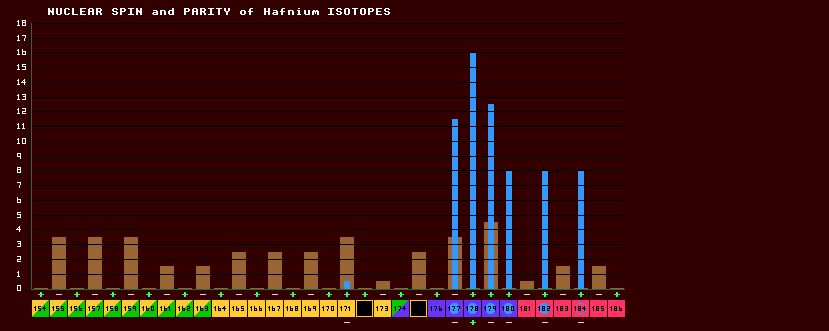

|
This cannot be called 'isotopic spin' because, contrarily, isotopic spin refers to a property of protons and neutrons which has nothing whatsoever to do with nuclear spin.
The spin of the nucleus is the vector sum of the spin of all its component nucleons, the protons and neutrons. The spin is either integral (bosonic) or half-integral (fermionic), depending upon whether the number of nucleons is an odd or even number; the even numbers giving rise to integral spins. The ground state spin for all even-N even-Z nuclei (the more stable nuclei containing an integral number of helium nuclei) is always zero, but for other nuclei the total spin is not necessarily the lowest value after pairing-off, as some spins remain un-paired giving spins as high as 10. The parity of a nucleus is the sign of the spin (rather than the magnitude), and is either odd (-) or even (+). Parity conservation is absolute except in the case of weak interactions (beta decay) where it is feebly broken. In a magnetic field cobalt-60 nuclei have a slight preference to decay emitting left-handed electrons. Isotopes with positive parity outnumber those with negative by about a factor of two. Similarly, because adjacent nuclei alternate between half-integral spin and integral spin like a chess board, you might think the two were equal in number, but half-integral spin nuclei are less stable than integral spin nuclei, so there are less of them in the extremities of the Segre chart where nuclei are generally less stable. The parity and spin are shown thus: 3/2+; in yellow for isotopes in their ground state, and in cyan for those in the first metastable state above the ground state, either IT isomers or those that decay by other routes, e.g. beta or inverse beta decay, etc. The parity of the ground state is also shown by the + - + + signs just beneath the histogram bars, whereas those for the metastable state just beneath the isotope boxes. The above diagram shows the nuclear spin and parity for isotopes of Hafnium. The ground-state spins are shown in brown, whilst the spin for metastable isotopes is shown in cyan. Note the distinct comb-like pattern of the ground state spins, showing that the odd-N (odd neutron number) nuclei possess overall spin, whilst the even-N nuclei all have zero spin (hafnium, Z=72, has an even number of protons, [Z-even] thus when neutron number is even, the nucleus has a whole number of helium nuclei, and all proton and neutron spins are paired up). The same is not true for excited (metastable) nuclei, whose spins are shown as cyan bars. Hafnium has some impressively high metastable spins, hafnium-178 having 16 units of spin. See Gamma Ray Laser, High Spin Nuclei and Quantum Nucleonic Reactor.
|
![]()